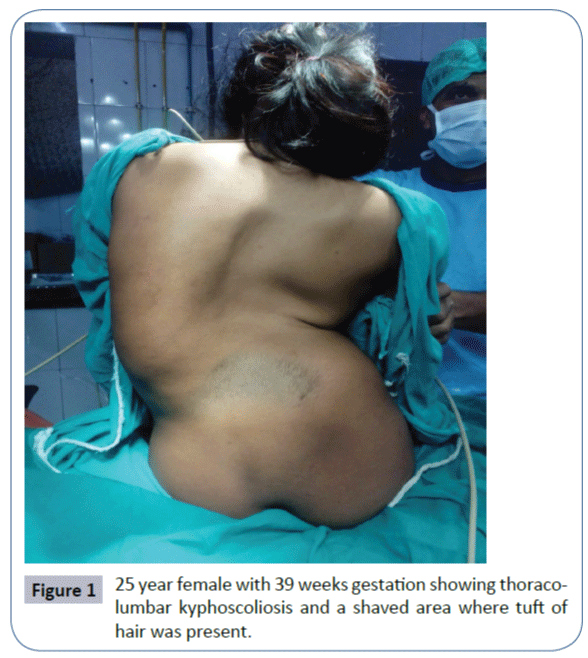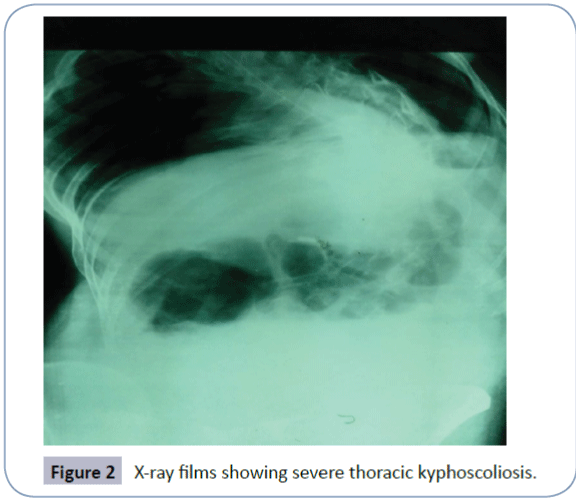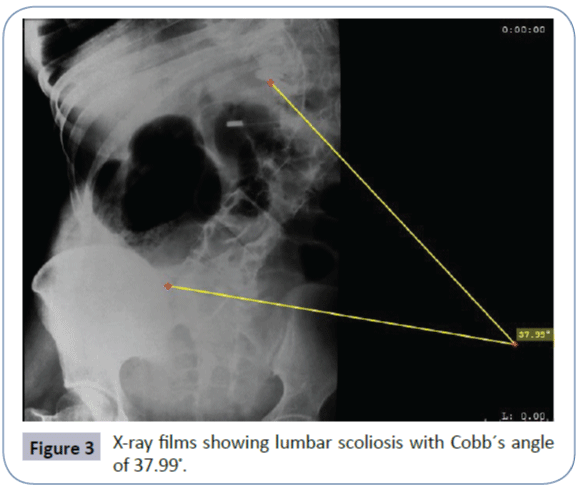Jaswant, Geeta Ahlawat*, Rajmala, Kirti, Jai Prakash and Nidhi
Department of Anaesthesiology and Critical Care, PG BD Sharma PGIMS Rohtak, Haryana, India
- *Corresponding Author:
- Geeta Ahlawat
Professor, Department of Anaesthesiology and Critical Care
PG BD Sharma PGIMS Rohtak, Haryana, India.
E-mail: Geeta Ahlawat
Received date: May 25, 2016; Accepted date: July 20, 2016; Published date: July 31, 2016
Citation: Jaswant, Ahlawat G, Rajmala, et al. Repeat Spinal Anesthesia after Failed Spinal Block for Emergency Caesarean Section in a Parturient with Kyphoscoliotic Spine Deformity. J Healthc Commun. 2016, 1:4. doi:10.4172/2472-1654.100028
Keywords
Repeat spinal anesthesia; Caesarean section; Kyphoscoliosis
Introduction
Kyphoscoliosis also known as “hunch back” involves kyphosis, which is antero-posterior angulation and scoliosis, which is the lateral curvature, rotation of the vertebrae and rib cage deformity. It can be idiopathic or secondary. Almost 80% of individuals with kyphoscoliosis fall in idiopathic group, with a female predominance of 4:1 [1]. The reported prevalence of scoliosis in the general population varies from 0.3-15.3% [2] while severe scoliosis is rare in parturient, which varies from 1 in 1500 to 1 in 12,000 pregnancies [1]. The thoracic deformity may lead to a significant restrictive lung disease, hypoxemia and cardiovascular compromise. Pregnancy may exacerbate both the severity of spinal curvature and cardiopulmonary abnormalities in women with uncorrected scoliosis.
Case Report
A female patient of 25 year age, 2nd gravida having 39 weeks gestation, 150 cm height with thoraco-lumbar kyphoscoliosis presented for emergency caesarean section in view of contracted pelvis in labor (Figure 1). She had history of spinal deformity since birth with inability to lie down in her left lateral position and previous lower segment caesarean section done under spinal anesthesia 2 years back, which was uneventful. She had complained of dyspnea on exertion (NYHA class II) since 2nd trimester of pregnancy. Her clinical examination revealed pulse rate 96/min regular, blood pressure 108/64 mmHg, chest bilateral clear, S1/S2 normal, mallampati grade-II, adequate mouth opening and normal neck movement. Her spine examination revealed a tuft of hairs in lumbar region and thoraco-lumbar kyphoscoliosis with concavity towards right. The interspinous space in lumbar region was not identifiable except L4-5. The available blood investigations (Hb 9.4 g%, BT/CT-2 min 10 sec/5 min 25 sec) and urine complete examination were normal. Her X-ray of thoracolumbar spine revealed severe kyphoscoliotic deformity (Figure 2). Cobb’s angle was found to be 38° as seen in Figure 3.
Figure 1: 25 year female with 39 weeks gestation showing thoracolumbar kyphoscoliosis and a shaved area where tuft of hair was present.
Figure 2: X-ray films showing severe thoracic kyphoscoliosis.
Figure 3: X-ray films showing lumbar scoliosis with Cobb´s angle of 37.99°.
Her pulmonary function tests and echocardiogram could not be done because of emergency scenario. We planned for neuroaxial anesthesia and the patient was explained for the same as well as about the sudden change of type of anesthesia as per need. The written consent was taken. Her management under regional (spinal) anesthesia is being discussed.
Half an hour before subarchnoid block injection ranitidine 50 mg and injection ondansetron 4 mg intravenous was administered as a premedication. In the operating room standard monitors were attached and baseline parameters were recorded. A peripheral line was secured with 18 G cannula. Preloading with IV fluid Ringer lactate 15 ml/kg was done. Patient was made to sit on the edge of OT table with both legs resting on a stool. Under all aseptic precautions, lumbar puncture was done using 23G Quincke’s needle at L4-5 interspace through midline approach. After obtaining free flow of clear CSF, 1.8 ml of 0.5% bupivacaine heavy was administered in the subarchnoid space. Patient was made supine and the level of sensory block was assessed using pin prick method. Only t12 level of sensory block along with motor block in bilateral lower limbs was achieved at 3 minutes of drug administration. There was no further improvement even after 15-20 degree Trendelenberg position. The patient was hemodynamically stable. Foetal heart rate was within normal limit as assessed by obstetrician.
After 15 minutes, a repeat subarchnoid block was administered in right lateral position in the same space with 1.5 ml of 0.5% bupivacaine heavy. Patient was again made supine with left lateral tilt of 15°. Immediately the level of sensory block was assessed. On left side T5 level of sensory block was achieved. On right side the level of block was T5 along with sparing of T7- 10 dermatomes. Immediately after repeat spinal block patient had single episode of hypotension (blood pressure of 81/45 mmHg) with heart rate of 112/min, which was easily managed with vasopressor mephentermine (two boluses of 3 mg each) and rapid infusion of fluid Ringer’s lactate. Surgery was allowed to start. Patient complained of pain and discomfort on deeper tissue dissection and wound stretching. Patient was sedated with inhalational agents using 50% O2 + 50% N2O + 1% sevoflurane with mask maintaining spontaneous ventilation for first 15 minutes. After that, patient remained comfortable throughout surgery with heart rate of 80-96/min and mean arterial pressure of 70-78 mmHg. Patient delivered a male baby of 2.4 kg with APGAR score of 7/10 at 1st and 9/10 at 5th min. total blood loss was 350 ml and total intravenous fluids given was 1.5 of Ringer’s lactate. At the end of surgery the patient was shifted to postoperative care unit where close monitoring for 24 hours was done. The level of block was once again assessed immediately in the postoperative period using pin prick method, which was T5 on both sides along with sparing of T7-10 dermatomes on the right side. However, the patient was comfortable and pain free. After two and half hours of postoperative period patient complained of pain for which intravenous infusion of paracetamol was given. Patient remained hemodynamically stable and no spinal anesthesia related complications were observed throughout the postoperative period.
Discussion
Kyphoscoliosis is mostly reported to be idiopathic (80%) with majority of patients being female (predominance of 4:1). Severe scoliosis is rare in parturient, which varies from 1 in 1500 to 1 in 12,000 pregnancies [1].
Severity of scoliosis and spinal deformity is best judged by determining Cobb’s angle which was 38° in our patient (Figure 3). Cobb’s angle correlates well with the functional lung impairment [3]. In case of thoracic involvement, the development of lung and alveoli is compromised, which lead to the development of restrictive lung disease and pulmonary arterial hypertension [4,5]. There is also a decrease in total lung capacity, vital capacity, functional residual capacity and tidal volume. All these changes were apparent in our patient. Perioperative morbidity and mortality increases if PaCO2 levels are increased or pulmonary hypertension is present during pregnancy [6], anticipating which we not only planned spinal anesthesia but also repeated it.
Normally inspired volume in a pregnant woman largely depends upon diaphragmatic excursion. In kyphoscoliotic patients the diaphragm is entirely responsible for all increments in minute ventilation. Diaphragmatic activity is constrained as the enlarging uterus enters the abdominal cavity in mid-gestation thus decreasing functional residual capacity (FRC) and closing capacity (CC). Decrease in FRC and CC more than the anticipated values results in ventilation perfusion mismatch and reduced arterial oxygen content. Minute volume increases by 40-50% due to increased tidal volume (TV) with relatively unchanged respiratory rate in normal parturient. In kyphoscoliotic patients with restrictive pattern, rise in TV is not possible and the increased minute ventilation is achieved via increased respiratory rate, thus elevating the work of breathing. Oxygen consumption increases above pre-labour values by 40% in the first stage and 70% in the second stage [7].
The increased airway resistance during pregnancy predisposes the patient to snoring and obstructive sleep apnea [8]. Our patient was having normal airway and respiratory system examination except dyspnea on exertional though we could not get pulmonary function due to emergency scenario.
Cardiac output increases to about 40% by the end of the first trimester and 50% above non pregnant levels by the third trimester, which is achieved by increase in both heart rate and stroke volume. In kyphoscoliotic patient, the peripheral vascular resistance (PVR) is increased so increase in cardiac output is not tolerated during pregnancy [6]. Our patient was having stable cardiovascular condition on clinical examination [9].
Both general anesthesia and central neuraxial anesthesia have been described for caesarean sections in patient with kyphoscoliosis and scoliosis [7], but anticipating all the above described problems, we not only planned spinal anesthesia, but also repeated it in our patient.
Regional anesthesia has several advantages over general, as patient remains awake, respiratory parameters are not further compromised, and problems like difficult airway management and delayed recovery are avoided. However major problem in administering regional anesthesia in such patients is the technical difficulty due to angulation and rotation of vertebral body as epidural space is deviated toward the convexity of angulation. Spinal or epidural block can be given by directing the needle toward the convexity of curve with significant angulation of the needle.
Huang has described a modified paramedian approach of spinal anesthesia in such patients [10]. In this approach, the skin is entered perpendicularly just lateral to the dorsal spine and advanced toward and onto the lamina. Then the needle is “walked” cephalad over the lamina until the interlaminar space is entered. Ko and Leffert reported in their neuraxial anesthesia review on anesthesia in scoliosis patients that in uncorrected scoliosis patient 8% have an asymmetric patchy block or unilateral block [11]. In our case there occurred failed spinal block on 1st attempt and sparing of T7-10 dermatomes of right side on 2nd attempt, which we were able to manage with inhalational sedation for first 15 minutes, at the moment when spinal blockade became complete up to T5 level, after which patient remained comfortable throughout surgery.
The causes of failed or patchy spinal block in kyphoscoliotic parturient could be either anatomical defect itself or improper placement of the local anesthetic, drug incompatibility, drug density and drug defects [3]. In our patient the level of block was T12 on 1st attempt and T5 on 2nd attempt, though patchy on right side. We used median approach in L4-5 intervertebral space which was the only palpable space in lumbar region. We decided to repeat the spinal block with lesser volume of drug (1.5 ml of 0.5% bupivacaine) which has also been reported earlier.
So, partial or patchy block in such patients may be due to some anatomical reason, preventing the spread of local anesthetic solution in the subarchnoid space, and this may hold true for the repeat injection also [3]. A repeat spinal block after a partial spinal block can lead to a high block due to the increased spread of the second dose of local anesthetic which did not happened in our case. In our view, a repeat injection with lesser drug volume should always be kept as an option in such patients like one- In emergency situation, full stomach and difficult airway.
Conclusion
A kyphoscoliotic parturient needs thorough preanaesthetic evaluation using multiple lab investigations, though it may not be possible in emergency scenario and the anesthesiologist is left to rely on the clinical parameters along with few blood investigations. Even though regional anesthesia is the preferred technique in a kyphoscoliotic parturient, there is high incidence of failure or patchy spinal block. A repeat spinal anesthesia with lesser volume of drug appears to be safe and should be considered as a reliable option after about 15-20 minutes of failed or partial 1st attempt block, if the maternal and foetal conditions allow as it helps avoid problems related to general anesthesia in such cases.
References
- James J (1976) Scoliosis. Edinburgh, Churchill Livingstone, pp: 182-187.
- Lonstein JE (1994) Adolescent idiopathic scoliosis. Lancet 344: 1407-1412.
- Kumar R, Singh K, Prasad G, Patel N (2014) Repeat spinal anaesthesia after a failed spinal block in a pregnant patient with kyphoscoliosis for elective caesarean section. J Obstet Anaesth Crit Care 4: 84-86.
- Kulkarni AH, Ambareesha M (2007) Scoliosis and anaesthetic considerations. IJA 51: 486-495.
- Kafer ER (1980) Respiratory and cardiovascular functions in scoliosis and the principles of anaesthetic management. Anaesthesiology 52: 339-351.
- Hung CT, Pelosi M, Langer A, Harrigan JT (1975) Blood gas measurements in the kyphoscoliotic gravida and her fetus: Report of a case. Am J Obstet Gynaecol 121: 287-289.
- Gupta S, Singariya G (2004) kyphoscoliosis and pregnancy- a case report. Indian J Anaesth 48: 215-220.
- Charbonneau M, Falcone T, Cosio MG, Levy RD (1991) Obstructive sleep apnea during pregnancy: therapy and implications for fetal health. Am Rev Respir Dis 144: 461.
- Gummerus M, Laasonen H (1981) Eisenmenger complex and pregnancy. Ann Chir Gynaecol 70: 339.
- Huang J (2010) Paramedian approach for neuraxialanaesthesia in parturients with scoliosis. Anaesth Analg 111: 821-822.
- Ko JY, Leffert LR (2009) Clinical implications of neuraxialanaesthesia in the parturient with scoliosis. Anaesth Analg 109:1930-193 4.




